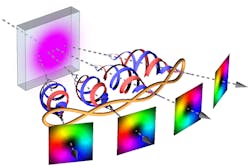An article in Physical Review Letters from physicists at the Leiden Institute of Physics (Leiden, Netherlands) explains how, for the first time, four photons have been entangled in their orbital angular momentum (OAM). Leiden physicists sent a laser through a crystal, thereby creating four photons with coupled 'rotation'. So far this has only been done for two photons. The researchers say the discovery makes uncrackable secret communication of complex information possible between multiple parties.
RELATED ARTICLE: The burgeoning usefulness of optical angular momentum
Entanglement holds a great promise, with applications in perfectly secret communication and quantum computing. If two photons are created simultaneously, they are each other's counterpart, so that their rotation is always reversed with respect to the other. If we measure left rotation for one photon, then the other will always rotate to the right after measurement with a similar filter. This is called entanglement. Before the measurement, each photon's rotation is undetermined.
This rotation is a property of photons that scientists discovered in 1992 in Leiden; physicists call this OAM. And this property has more than two values. It covers an infinitely large alphabet of information. So with this you can transfer much more information per photon than with a property like polarization, which contains only two possible values.
In 2001, scientists managed to entangle two photons in OAM for the first time. Now, Leiden physicist Wolfgang Löffler and his colleagues are the first ones to entangle four photons in this way.
During their successful experiment, the researchers sent short ultraviolet laser pulses of 2 ps through a crystal. Occasionally this leads to the creation of four entangled photons. This is extremely rare, but by generating 80 million pulses per second they managed to detect on average two so-called photon quadruplets each second. To confirm these were indeed entangled in OAM, the team used a spatial phase modulator that converts this ‘rotation’ back to light traveling as a plane wave. They registered this ‘normal’ light with single-photon detectors.
SOURCE: Leiden Institute of Physics; http://www.physics.leidenuniv.nl/index.php?id=11573&news=824&type=LION&ln=EN

Gail Overton | Senior Editor (2004-2020)
Gail has more than 30 years of engineering, marketing, product management, and editorial experience in the photonics and optical communications industry. Before joining the staff at Laser Focus World in 2004, she held many product management and product marketing roles in the fiber-optics industry, most notably at Hughes (El Segundo, CA), GTE Labs (Waltham, MA), Corning (Corning, NY), Photon Kinetics (Beaverton, OR), and Newport Corporation (Irvine, CA). During her marketing career, Gail published articles in WDM Solutions and Sensors magazine and traveled internationally to conduct product and sales training. Gail received her BS degree in physics, with an emphasis in optics, from San Diego State University in San Diego, CA in May 1986.
